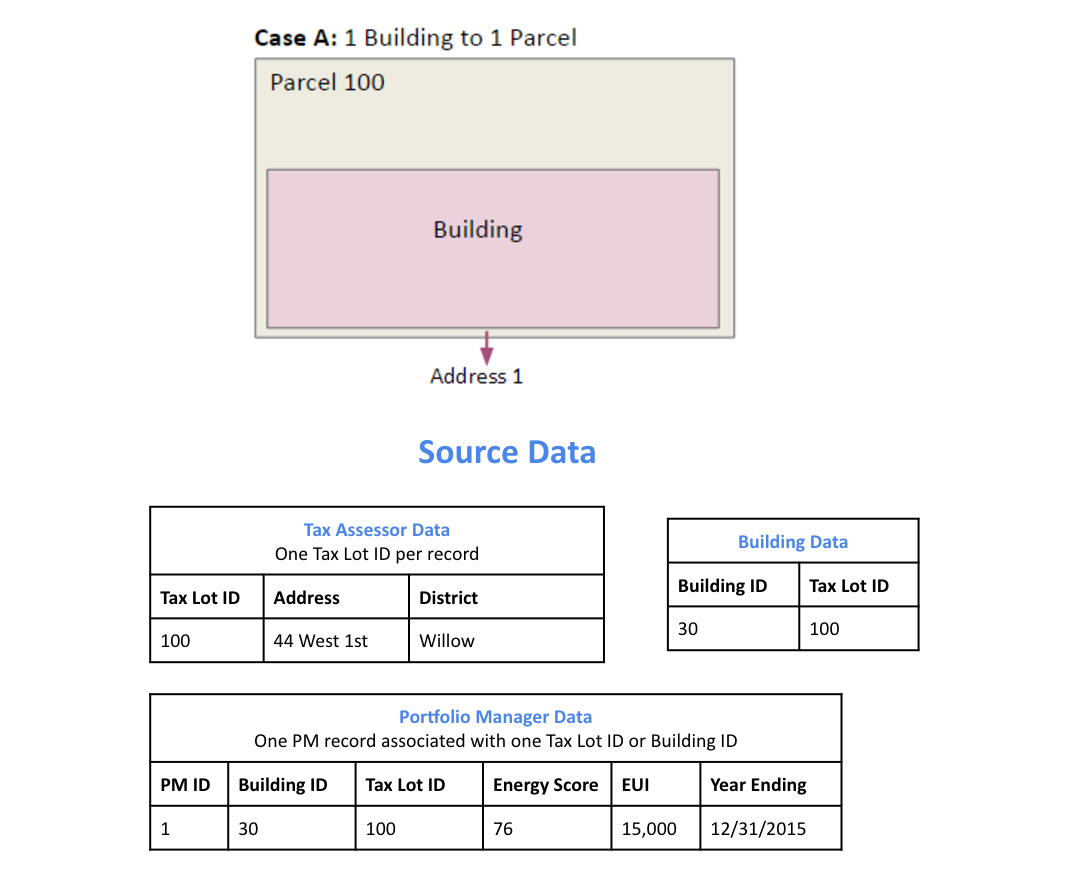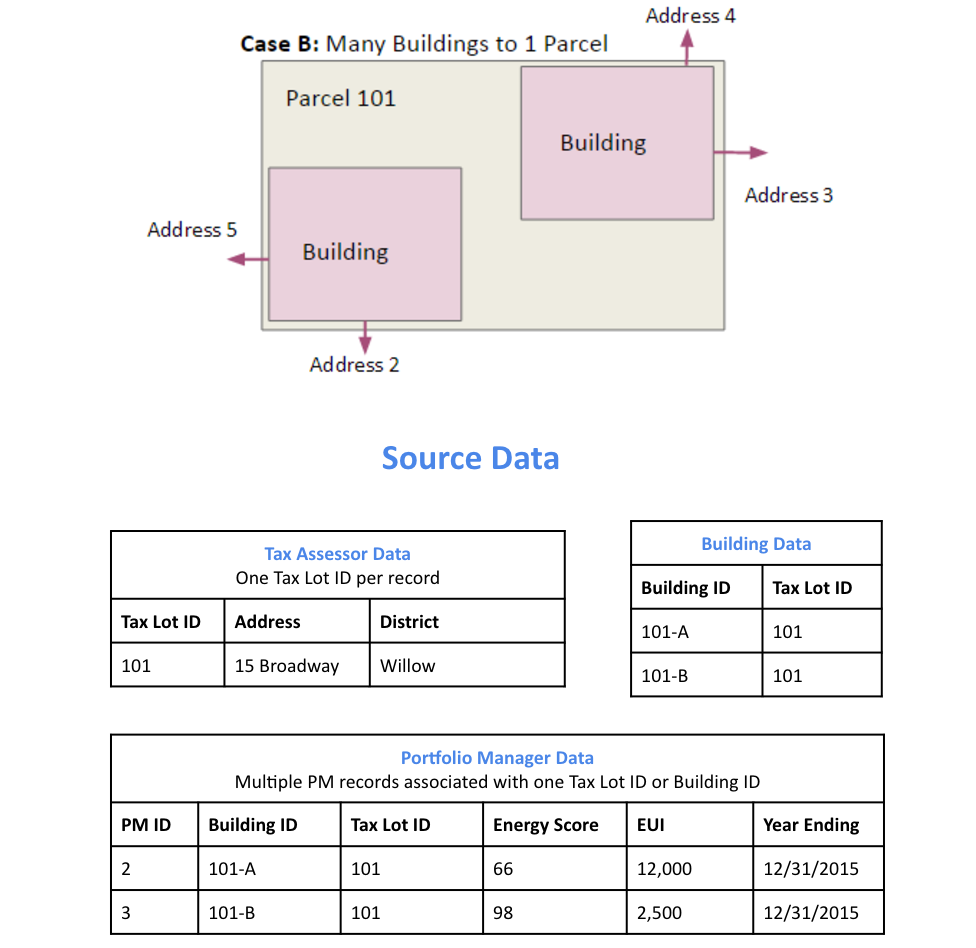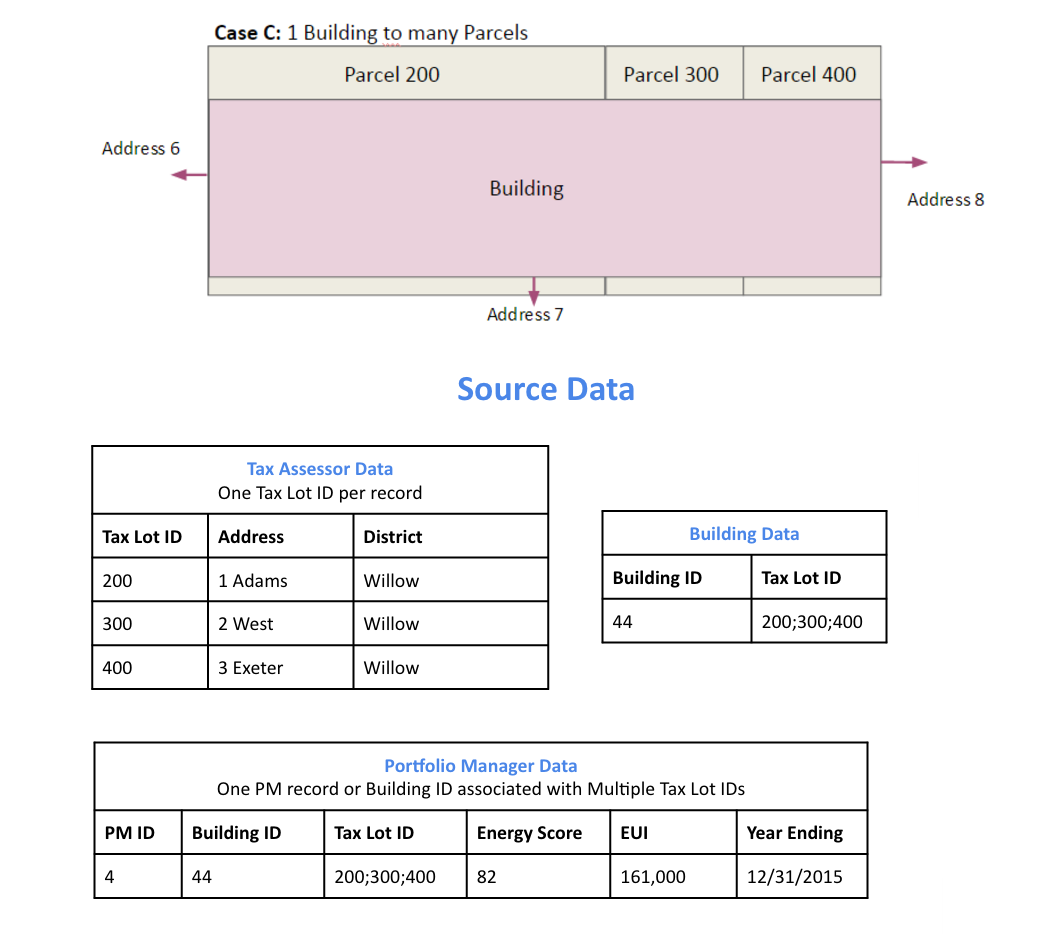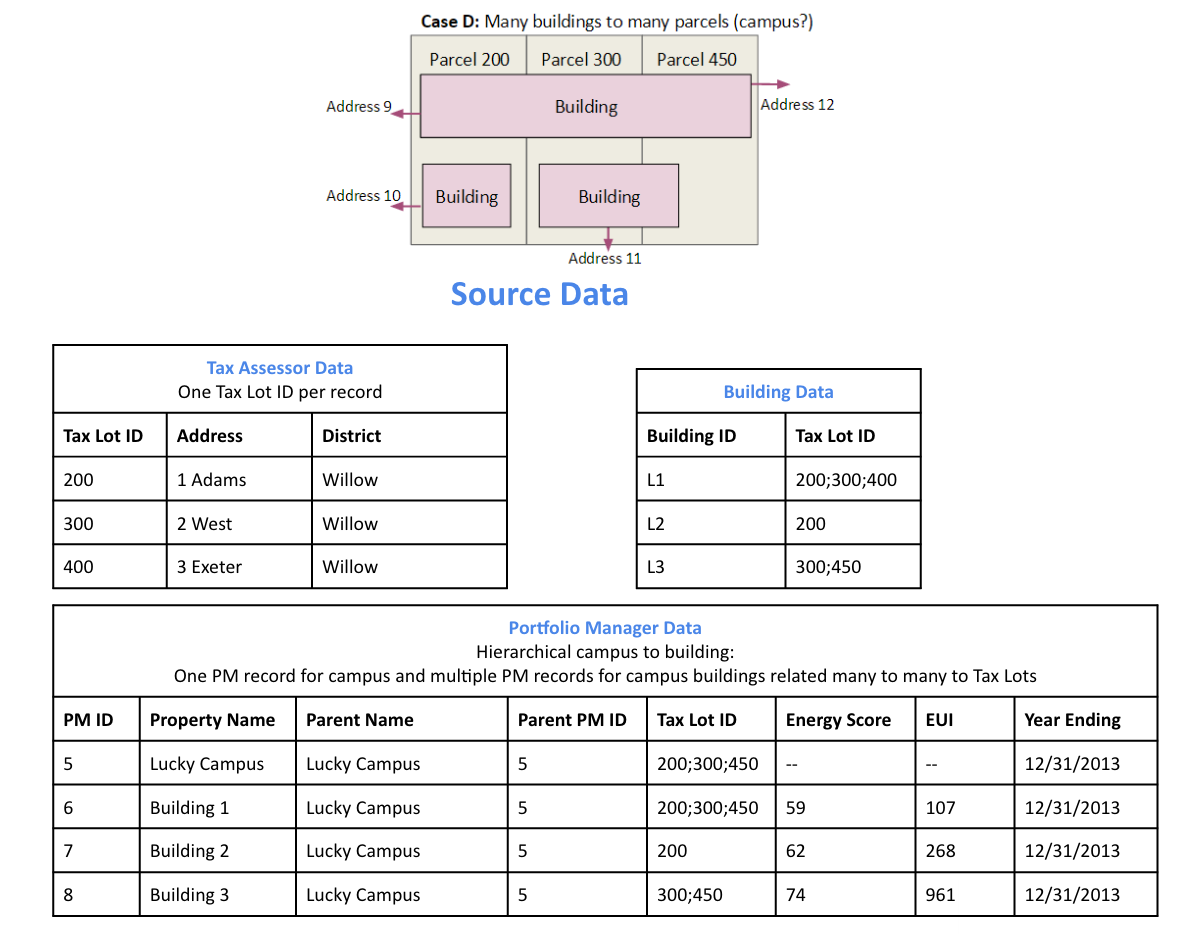Data Model





Todo
Documentation below is out of state and needs updated.
Our primary data model is based on a tree structure with BuildingSnapshot instances as nodes of the tree and the tip of the tree referenced by a CanonicalBuilding.
Take the following example: a user has loaded a CSV file containing information about one building and created the first BuildingSnapshot (BS0). At this point in time, BS0 is linked to the first CanonicalBuilding (CB0), and CB0 is also linked to BS0.
BS0 <-- CB0
BS0 --> CB0
These relations are represented in the database as foreign keys from the BuildingSnapshot table to the CanonicalBuilding table, and from the CanonicalBuilding table to the BuildingSnapshot table.
The tree structure comes to fruition when a building, BS0 in our case, is matched with a new building, say BS1, enters the system and is auto-matched.
Here BS1 entered the system and was matched with BS0. When a match occurs, a new BuildingSnapshot is created, BS2, with the fields from the existing BuildingSnapshot, BS0, and the new BuildingSnapshot, BS1, merged together. If both the existing and new BuildingSnapshot have data for a given field, the new record’s fields are preferred and merged into the child, B3.
The fields from new snapshot are preferred because that is the newer of the two records from the perspective of the system. By preferring the most recent fields this allows for evolving building snapshots over time. For example, if an existing canonical record has a Site EUI value of 75 and some changes happen to a building that cause this to change to 80 the user can submit a new record with that change.
All BuildingSnapshot instances point to a CanonicalBuilding.
BS0 BS1
\ /
BS2 <-- CB0
BS0 --> CB0
BS1 --> CB0
BS2 --> CB0
parents and children
BuildingSnapshots also have linkage to other BuildingSnapshots in order to keep track of their parents and children. This is represented in the Django model as a many-to-many relation from BuildingSnapshot to BuildingSnapshot. It is represented in the PostgreSQL database as an additional seed_buildingsnapshot_children table.
In our case here, BS0 and BS1 would both have children BS2, and BS2 would have parents BS0 and BS1.
Note
throughout most of the application, the search_buildings endpoint
is used to search or list active building. This is to say, buildings that
are pointed to by an active CanonicalBuilding.
The search_mapping_results endpoint allows the search of buildings
regardless of whether the BuildingSnapshot is pointed to by an active
CanonicalBuilding or not and this search is needed during the mapping
preview and matching sections of the application.
For illustration purposes let’s suppose BS2 and a new building BS3 match to form a child BS4.
parent |
child |
|---|---|
BS0 |
BS2 |
BS1 |
BS2 |
BS2 |
BS4 |
BS3 |
BS4 |
And the corresponding tree would look like:
BS0 BS1
\ /
BS2 BS3
\ /
BS4 <-- CB0
BS0 --> CB0
BS1 --> CB0
BS2 --> CB0
BS3 --> CB0
BS4 --> CB0
matching
During the auto-matching process, if a raw BuildingSnapshot matches an existing BuildingSnapshot instance, then it will point to the existing BuildingSnapshot instance’s CanonicalBuilding. In the case where there is no existing BuildingSnapshot to match, a new CanonicalBuilding will be created, as happened to B0 and C0 above.
field |
BS0 |
BS1 |
BS2 (child) |
|---|---|---|---|
id1 |
11 |
11 |
11 |
id2 |
12 |
12 |
|
id3 |
13 |
13 |
|
id4 |
14 |
15 |
15 |
manual-matching vs auto-matching
Since BuildingSnapshots can be manually matched, there is the possibility for two BuildingSnapshots each with an active CanonicalBuilding to match and the system has to choose to move only one CanonicalBuilding to the tip of the tree for the primary BuildingSnapshot and deactivate the secondary BuildingSnapshot’s CanonicalBuilding.
Take for example:
BS0 BS1
\ /
BS2 BS3
\ /
BS4 <-- CB0 (active: True) BS5 <-- CB1 (active: True)
If a user decides to manually match BS4 and BS5, the system will take the
primary BuildingSnapshot’s CanonicalBuilding and have it point to their
child and deactivate CB1. The deactivation is handled by setting a field
on the CanonicalBuilding instance, active, from True to False.
Here is what the tree would look like after the manual match of BS4 and BS5:
BS0 BS1
\ /
BS2 BS3
\ /
BS4 BS5 <-- CB1 (active: False)
\ /
BS6 <-- CB0 (active: True)
Even though BS5 is pointed to by a CanonicalBuilding, CB1, BS5 will not be
returned by the normal search_buildings endpoint because the
CanonicalBuilding pointing to it has its field active set to False.
Note
anytime a match is unmatched the system will create a new
CanonicalBuilding or set an existing CanonicalBuilding’s active field to
True for any leaf BuildingSnapshot trees.
what really happens to the BuildingSnapshot table on import (and when)
The above is conceptually what happens but sometimes the devil is in the details. Here is what happens to the BuildingSnapshot table in the database when records are imported.
Every time a record is added at least two BuildingSnapshot records are created.
Consider the following simple record:
Property Id |
Year Ending |
Property Floor Area |
Address 1 |
Release Date |
|---|---|---|---|---|
499045 |
2000 |
1234 |
1 fake st |
12/12/2000 |
The first thing the user is upload the file. When the user sees the “Successful Upload!” dialog one record has been added to the BuildingSnapshot table.
This new record has an id (73700 in this case) and a created and modified timestamp. Then there are a lot of empty fields and a source_type of 0. Then there is the extra_data column which contains the contents of the record in key-value form:
- Address 1:
“1 fake st”
- Property Id:
“499045”
- Year Ending:
“2000”
- Release Date:
“12/12/2000”
- Property Floor Area:
“1234”
And a corresponding extra_data_sources that looks like
- Address 1:
73700
- Property Id:
73700
- Year Ending:
73700
- Release Date:
73700
- Property Floor Area:
73700
All of the fields that look like _source_id are also populated with 73700 E.G. owner_postal_code_source_id.
The other fields of interest are the organization field which is populated with the user’s default organization and the import_file_id field which is populated with a reference to a data_importer_importfile record.
At this point the record has been created before the user hits the “Continue to data mapping” button.
The second record (id = 73701) is created by the time the user gets to the screen with the “Save Mappings” button. This second record has the following fields populated:
id
created
modified
pm_property_id
year_ending
gross_floor_area
address_line_1
release_date
source_type (this is 2 instead of 0 as with the other record)
import_file_id
organization_id.
That is all. All other fields are empty. In this case that is all that happens.
Now consider the same user uploading a new file from the next year that looks like
Property Id |
Year Ending |
Property Floor Area |
Address 1 |
Release Date |
|---|---|---|---|---|
499045 |
2000 |
1234 |
1 fake st |
12/12/2001 |
As before one new record is created on upload. This has id 73702 and follows the same pattern as 73700. And similarly 73703 is created like 73701 before the “Save Mappings” button appears.
However this time the system was able to make a match with an existing record. After the user clicks the “Confirm mappings & start matching” button a new record is created with ID 73704.
73704 is identical to 73703 (in terms of contents of the BuildingSnapshot table only) with the following exceptions:
created and modified timestamps are different
match type is populated and has a value of 1
confidence is populated and has a value of .9
source_type is 4 instead of 2
canonical_building_id is populated with a value
import_file_id is NULL
last_modified_by_id is populated with value 2 (This is a key into the landing_seeduser table)
address_line_1_source_id is 73701
gross_floor_area_source_id is populated with value 73701
pm_property_id_source_id is populated with 73701
release_date_source_id is populated with 73701
year_ending_source_id is populated with 73701
what really happens to the CanonicalBuilding table on import (and when)
In addition to the BuildingSnapshot table the CanonicalBuilding table is also updated during the import process. To summarize the above 5 records were created in the BuildingSnapshot table:
73700 is created from the raw 2000 data
73701 is the mapped 2000 data,
73702 is created from the raw 2001 data
73703 is the mapped 2001 data
73704 is the result of merging the 2000 and 2001 data.
In this process CanonicalBuilding is updated twice. First when the 2000 record is imported the CanonicalBuilding gets populated with one new row at the end of the matching step. I.E. when the user sees the “Load More Data” screen. At this point there is a new row that looks like
id |
active |
canonical_building_id |
|---|---|---|
20505 |
TRUE |
73701 |
At this point there is one new canonical building and that is the BuildingSnapshot with id 73701. Next the user uploads the 2001 data. When the “Matching Results” screen appears the CanonicalBuilding table has been updated. Now it looks like
id |
active |
canonical_building_id |
|---|---|---|
20505 |
TRUE |
73704 |
There is still only one canonical building but now it is the BuildingSnapshot record that is the result of merging the 2000 and 2001 data: id = 73704.
organization
BuildingSnapshots belong to an Organization field that is a foreign key into the organization model (orgs_organization in Postgres).
Many endpoints filter the buildings based on the organizations the requesting user belongs to. E.G. get_buildings changes which fields are returned based on the requesting user’s membership in the BuildingSnapshot’s organization.
*_source_id fields
Any field in the BuildingSnapshot table that is populated with data from a submitted record will have a corresponding _source_id field. E.G pm_property_id has pm_property_id_source_id, address_line_1 has address_line_1_source_id, etc…
These are foreign keys into the BuildingSnapshot that is the source of that value. To extend the above table
field |
BS0 |
BS1 |
BS2 (child) |
BS2 (child) _source_id |
|---|---|---|---|---|
id1 |
11 |
11 |
BS0 |
|
id2 |
12 |
12 |
BS1 |
NOTE: The BuildingSnapshot records made from the raw input file have all the _source_id fields populated with that record’s ID. The non-canonical BuildingSnapshot records created from the mapped data have none set. The canonical BuildingSnapshot records that are the result of merging two records have only the _source_id fields set where the record itself has data. E.G. in the above address_line_1 is set to “1 fake st.” so there is a value in the canonical BuildingSnapshot’s address_line_1_source_id field. However there is no block number so block_number_source_id is empty. This is unlike the two raw BuildingSnapshot records who also have no block_number but nevertheless have a block_number_source_id populated.
extra_data
The BuildingSnapshot model has many “named” fields. Fields like “address_line_1”, “year_built”, and “pm_property_id”. However the users are allowed to submit files with arbitrary fields. Some of those arbitrary fields can be mapped to “named” fields. E.G. “Street Address” can usually be mapped to “Address Line 1”. For all the fields that cannot be mapped like that there is the extra_data field.
extra_data is Django json field that serves as key-value storage for other user-submitted fields. As with the other “named” fields there is a corresponding extra_data_sources field that serves the same role as the other _source_id fields. E.G. If a BuildingSnapshot has an extra_data field that looks like
- an_unknown_field:
1
- something_else:
2
It should have an extra_data_sources field that looks like
- an_unknown_field:
some_BuildingSnapshot_id
- something_else:
another_BuildingSnapshot_id
saving and possible data loss
When saving a Property file some fields that are truncated if too long. The following are truncated to 255 characters
jurisdiction_tax_lot_id
pm_property_id
custom_id_1
ubid
lot_number
block_number
district
owner
owner_email
owner_telephone
owner_address
owner_city_state
owner_postal_code
And the following are truncated to 255:
property_name
address_line_1
address_line_2
city
postal_code
state_province
building_certification
No truncation happens to any of the fields stored in extra_data.